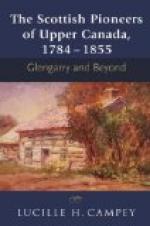But the winter changed these conditions, the rivers became coated with thick ice, and the ground was covered, except in steep places, with an unvarying mantle of snow. Yet transport became just as easy as in the summertime, though perhaps a trifle more fatiguing. Men and women put on snowshoes shaped like tennis rackets, and flew over the hard snow quicker than a canoe could travel, dragging after them small sledges on which their luggage was packed; or, if they had not much luggage, carrying it slung round the shoulders and scurrying away on their snowshoes even swifter for the weight they carried; or they travelled over the smooth ice of the rivers and lakes.
Winter travellers, however, were sometimes troubled with a disorder known as the snowshoe evil. This arose from the placing of an unusual strain on the tendons of the leg, occasioned by the weight of the snowshoe. It often resulted in severe inflammation of the lower leg. The local remedy was a drastic one: it was to place a piece of lighted touchwood on the most inflamed part, and to leave it there till the flesh was burnt to the nerve!
In the north and the regions round Hudson’s Bay, and also in the far west—British Columbia and Alaska—there were dogs, more or less of the Eskimo breed, trained by Eskimo or by Amerindians to drag the sledges. In the months of December and January it is true that the daylight in Arctic Canada (north of Lake Athapaska) became so short that the sun at its greatest altitude only appeared for two or three hours a short distance above the horizon. But there were compensations. The brilliancy of the Aurora Borealis, even without the assistance of the moon and the stars, made some amends for that deficiency, for it was frequently so light all night that travellers could see to read a very small print (Samuel Hearne). The importance of these “Northern lights” must not be overlooked in forming an opinion on the habitability of the far north in the “dark” winter months. The display was frequent and brilliant.
The Athapaskan Indians called this phenomenon Edthin, that is to say, “reindeer”. When the Aurora Borealis was particularly bright in the sky they would say that deer were plentiful in that part of the heavens. Their fancy in this respect was not quite so silly as one might think. They had learnt from experience that the Aurora Borealis was in some way connected with electricity, and experience had equally shown them that the skin of the reindeer, if briskly stroked by the hand on a dark night, would emit as many electric sparks as the back of a cat. On the other hand, the Amerindians in the southern and more temperate regions thought the Aurora Borealis was a vast concourse of “spirits of the happy day” dancing in the clouds.




